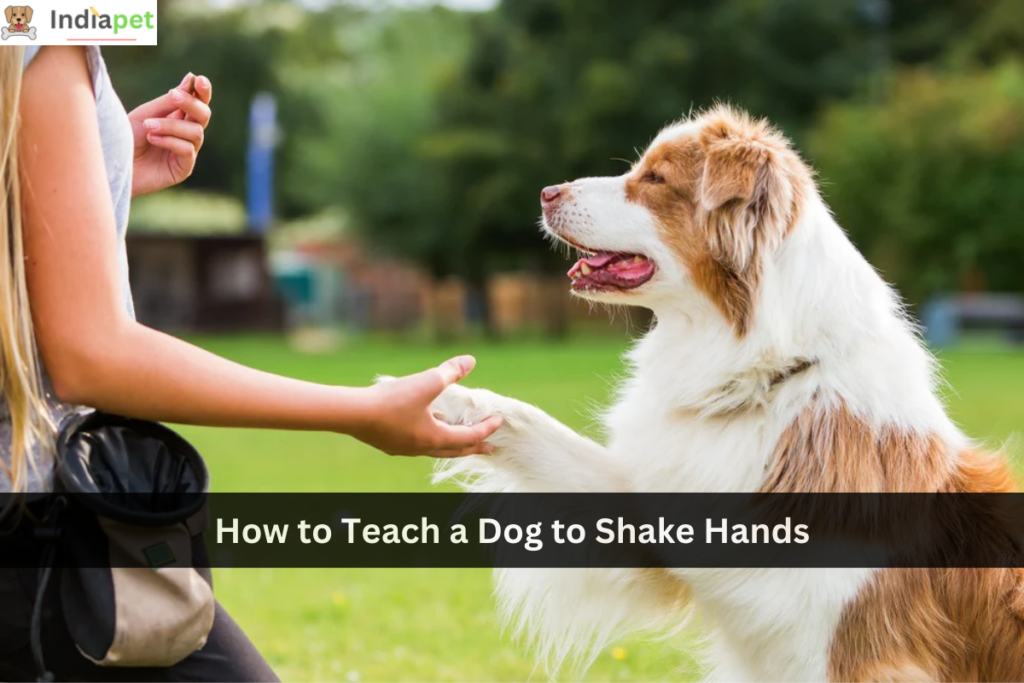How to Teach a Dog to Shake Hands: If you’ve ever wanted to impress your friends with your dog’s impressive repertoire of tricks, teaching them to shake hands is an essential skill. Not only is it a simple and adorable trick, but it also demonstrates your dog’s ability to listen and follow cues. In this article, we’ll guide you through the steps on how to teach a dog to shake hands.
How to Teach a Dog to Shake Hands
The Importance of Teaching Your Dog Tricks
Teaching your dog tricks goes beyond just providing entertainment for yourself and others. It is a valuable way to engage your dog’s mind, stimulate their problem-solving skills, and build a stronger bond between you and your furry friend. Dogs are intelligent creatures that thrive on mental stimulation, and teaching them tricks is a fantastic way to fulfill this need.
The Benefits of Teaching Your Dog to Shake Hands
Aside from the entertainment value, teaching your dog to shake hands carries several benefits. Firstly, it improves your dog’s obedience as they learn to respond to your commands. This skill also enhances their socialization skills, making them more comfortable with strangers and other pets. Moreover, teaching your dog tricks like shaking hands can be a useful icebreaker in various social situations.
Understanding the Basics of Dog Training
Before diving into teaching your dog to shake hands, it’s crucial to understand the fundamentals of dog training. Positive reinforcement is the key to successful training. This involves rewarding your dog for exhibiting the desired behavior, whether through treats, praise, or play. It’s essential to avoid punishment or negative reinforcement, as this can lead to fear and anxiety in your dog.
Preparing for the Training Session
Before starting the training session, ensure that you have a quiet and distraction-free environment. This will help your dog focus and maintain their attention on the task at hand. Gather some small, tasty treats that your dog loves, as these will serve as rewards during the training process. Additionally, have a clicker or a marker word handy to signal to your dog that they have performed the correct behavior.
Step-by-Step Guide to Teaching Your Dog to Shake Hands
Step 1: Capture the behavior
- Start by observing your dog’s natural behavior. Whenever they lift their paw, say the cue word “shake” or “paw” and immediately reward them with a treat. This will help your dog associate the cue word with the desired behavior.
Step 2: Add a visual cue
- Once your dog starts to understand the association between the cue word and lifting their paw, it’s time to introduce a visual cue. Gently take your dog’s paw in your hand and say the cue word. As soon as they lift their paw, reward them with a treat and plenty of praise. Repeat this process several times until your dog starts lifting their paw in response to the visual cue alone.
Step 3: Add the shake motion
- Now it’s time to teach your dog to actually shake hands. As your dog lifts their paw in response to the visual cue, take their paw in your hand and gently shake it. Reward them with a treat and praise. Repeat this step, gradually increasing the duration of the shake until your dog becomes comfortable with the motion.
Also See:
A 3-Step Guide To Keeping Your Pet’s Fur Shiny And Healthy
Troubleshooting Common Challenges During the Training Process
While teaching your dog to shake hands is a relatively simple trick, you may encounter some challenges along the way. Here are a few common issues and how to address them:
- Lack of interest or motivation
- If your dog seems uninterested or unmotivated during the training sessions, try using higher-value treats or toys as rewards. You can also try changing the training environment to make it more stimulating and engaging for your dog.
- Difficulty in lifting the paw
- Some dogs may struggle with lifting their paw initially. In such cases, you can gently guide their paw with your hand to help them understand the desired behavior. Gradually reduce your physical assistance until they can lift their paw independently.
- Confusion with other commands
- If your dog is already familiar with other commands, they may get confused initially. To avoid this, ensure that you use a distinct cue word and visual cue specifically for the handshake trick. Consistency is key in helping your dog understand and differentiate between various commands.
Advanced Tricks to Teach Your Dog After Mastering the Handshake
Once your dog has mastered shaking hands, you can build upon this foundation to teach them more advanced tricks. Some popular options include teaching them to high-five, wave, or even fist bump. These tricks not only showcase your dog’s intelligence but also provide further mental stimulation.
Resources and Tools for Dog Training
There are numerous resources and tools available to assist you in your dog training journey. Dog training books, online tutorials, and professional dog trainers can provide valuable guidance and support. Additionally, interactive puzzle toys and treat-dispensing devices can keep your dog mentally engaged and entertained.
Conclusion
Teaching your dog to shake hands is a fun and rewarding experience for both you and your furry friend. It strengthens the bond between you, improves obedience, and enhances their socialization skills. With patience, positive reinforcement, and consistent practice, you’ll be amazed at how quickly your dog learns this impressive trick. So, grab some treats, get ready to have fun, and watch your dog’s paw-shaking prowess shine!
If you like this Article about How to Teach a Dog to Shake Hands please share this Article with your friends and family members.


